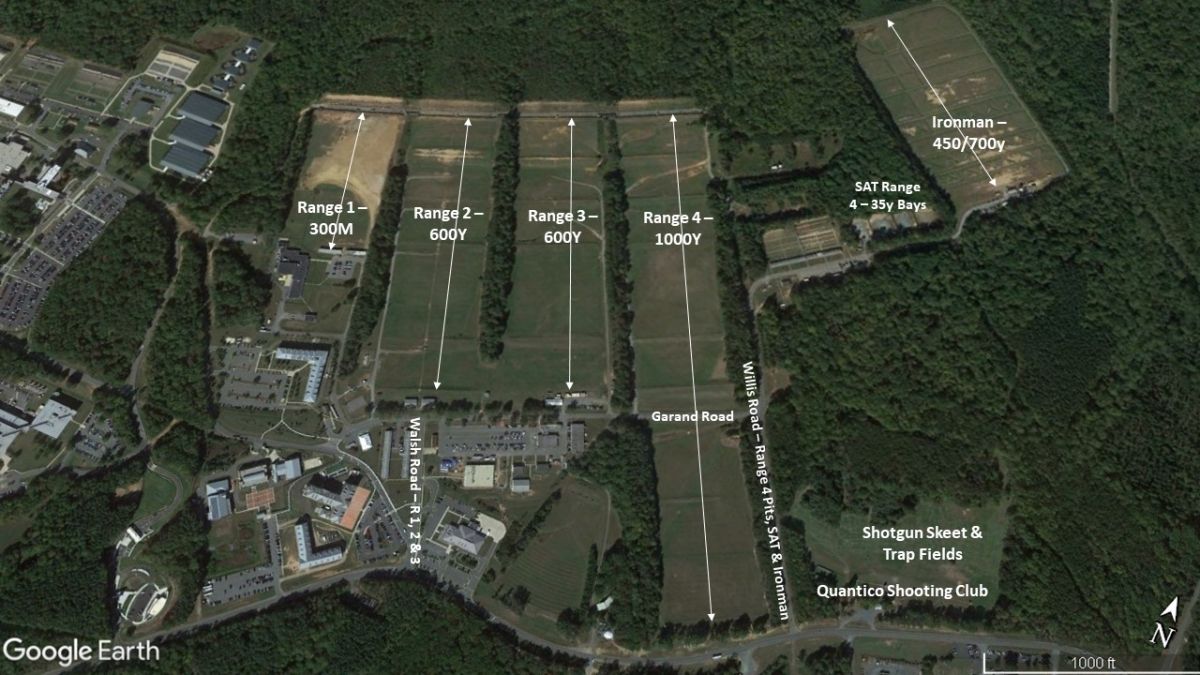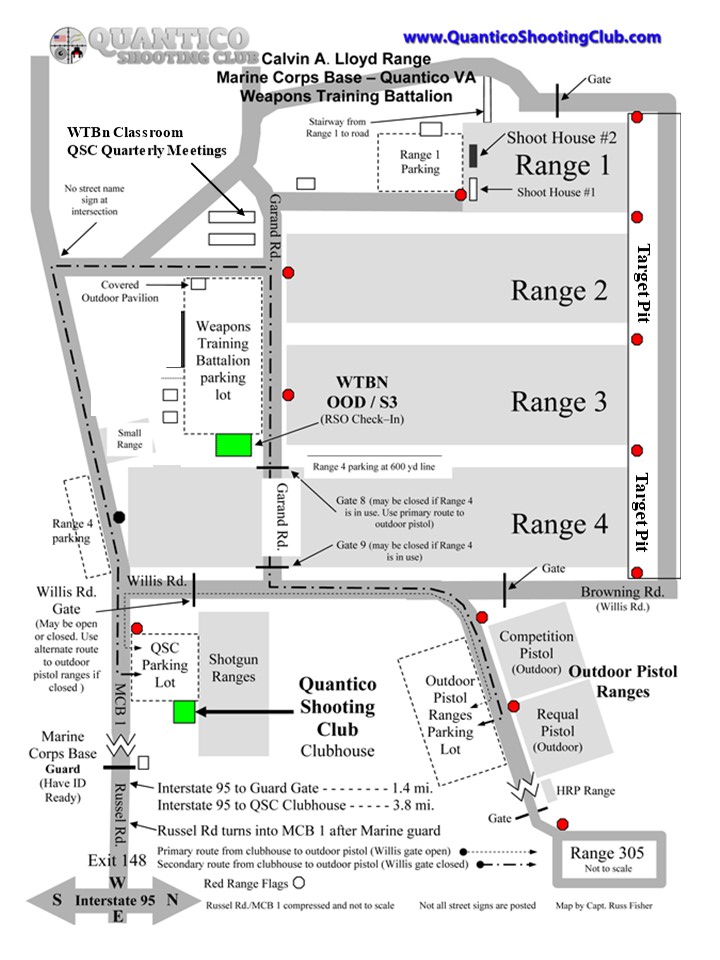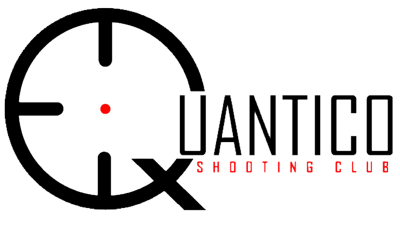The USMC and QSC Ranges:
The Quantico ranges and training area encompass 54,440 acres with 184 sq. mi. of Special Use Airspace that has a 15,000' ceiling, 55 active live and non-live fire ranges and training facilities, 39 Training Areas, 66 Landing Zones, 3 Drop Zones, and a full scope of military and law enforcement training from small arms familiarization, to company-size live fire and maneuver, to delivery of aerial ordnance.
QSC is fortunate to have the use of one small portion of the Quantico ranges, the Calvin A. Lloyd Range complex adjacent to the Weapons Training Battalion area. The map (below) shows the rifle, pistol, tactical and shotgun ranges we utilize on weekends, and the surrounding Weapons Training Battalion area.
- MCBQ Range Regulations can be found here and range Standard Operating Procedures are on the same page under Ranges, the Small Arms tab
- Members can bring guests for a range day after the guest signs a waiver and pays a range fee of $20 at the clubhouse
- Please bring your own targets and stands, the QSC does not provide either
- Rules are strict regarding the transport of firearms on the base, Please read Transporting Firearms prior to visiting
- NFA items (Short-barreled rifles and Suppressors) are allowed - Full automatic or the simulation of full-auto fire is NOT allowed
A short video on how to have a successful range day at the QSC.
Our digital assistant (Monica) offers one minute of hints, tips and advice before you come to the range. More detailed information on each range and how they operate are below.
How the QSC Ranges Operate:
You must bring your own targets (and target stands unless using a KD frame), hydration, sunscreen, bug spray, ear and eye protection, etc. Always check the club calendar for any last minute changes before coming to the range. Our digital assistant provides a brief overview of range operations.
How the Club Calendar Works: The Marines only notify the QSC of range availability the Sunday prior to the coming weekend. QSC notifies our Range Safety Officers (RSOs) which ranges are available and the RSOs sign up to open and operate a range (remember, we need 3 RSOs to open each range). On Thursday night we finalize the available ranges and place them on the Club's Calendar for the upcoming weekend. We understand it's not the most responsive system, but we do follow Marine Corps policies. ALWAYS check the club's calendar before coming to the range in case of last minute changes or closures.
Each range has its own "pace." Regardless of the range, the RSO notes for the day's sequence are linked from the Calendar. Those notes establish the final rules for that day's activities on that particular range.
Range 1 and Ironman are "Recreational Fire Ranges" that allow rifles, pistols, shotguns, black powder, air rifles, etc. A shooter can have a pistol target at 7 yards and their rifle target at 100 yards in your firing lane. A recreational fire range will open, for example, at 8am for range set-up, target placement and safety briefs. First shot would be at 9am and the range would go Hot for 45 minutes, then go Cold for 15 minutes for new people to set-up, shooters to depart and targets to be checked. This routine would be followed until the last changeover, usually an hour before the range closes.
- Range 1 has a 21-position shoot house and allows targets from 7 yards to 328 yards (300 meters).
- The firing line can be moved forward to accommodate more shooters so always be prepared with the correct accessories
- There are restrictions on holster drawing on Range 1 due to the concrete shooting pad - Check with the RSO for details
- Shooters on Range 1 cannot shoot .338 Lapua. Other large magnum calibers are approved by Range Control when called in by the RSO (such as 50BMG or 300WM)
- There are restrictions on steel placement, based on caliber, which are published in the RSOs range notes on the calendar
- Ironman is an open air range that can handle 70 shooters with target placement from 7 yards to 450 yards, and there is steel in the treeline out to 700 yards.
- There are no caliber restrictions, however, calibers are "approved" by range control at the time the range is opened and dependent on things like adjacent range activities and airspace so, on some days, not all calibers may be approved for use
- There are restrictions on drills and holster draw on Ironman due to the shere number of shooters on the firing line - Check with the RSO for details
- There are restrictions on steel placement, based on caliber, which are published in the RSOs range notes on the calendar
Ranges 2 and 3 are "Structured Fire Ranges" for rifles out to 600 yards and usually only used for the rifle teams or shooters practicing for inter-service matches, across the course (service rifle), Camp Perry, etc. These ranges are placed on the club calendar and operate at the pace of the shooters or the course of fire they are practicing. QSC does not routinely open ranges 2 and 3 as it then creates a safety "conflict" with Ranges 1 and 4 requiring us to close those ranges..
Range 4 is a "Precision Fire Range" for rifles out to 1,000 yards. Range 4 operates at a different pace than a Rec Fire Range as shooters all have electronic scoring, target cameras, steel, etc., offering immediate visual or auditory feedback so, shooters do not have to go down range for target checks.Range 4 will typicallly open the pit gates at 0715 for target placement, close the gate at 0745, hold their safety brief and then have first shot at 8am. The shooters determine when they will go cold, but it may not be until 9:30 or 10am. If you are late, you will wait.
- RSOs determine the course of fire and publish it on their range notes in the calendar. RSO may shoot a 100, 300, 600 yard day, a 1,000 yard day or combinations, check the calendar for the notes
- There may be QSC steel placed on the right side of the range at differing distances for shooters to test their skills and their loads, check the calendar, which will state if steel is present
- There are no caliber restrictions, however, calibers are "approved" by range control at the time the range is opened and dependent on things like adjacent range activities and airspace so, on some days, not all calibers may be approved for use
- If adjacent ranges are operating, it may limit Range 4 to 1,000 yard firing
- Shooters cannot place targets at, for instance, the 100 yard berm when shooting a 1,000 yard day. Shorter shooting distances are reserved for Recreational Fire ranges
RSOs are the Lifeblood of the QSC:
The backbone of Quantico Shooting Club is our cadre of volunteer Range Safety Officers and we need three RSOs to open each range. Please take the time to thank your RSOs for volunteering and giving up their time for your benefit. RSOs are our lifeblood, if we lose them, we lose the club so please join the RSO ranks. Visit our Range Safety section to learn more about becoming an RSO.
A Google Earth Range Map:

A Consolidated Range Map (not to scale):

